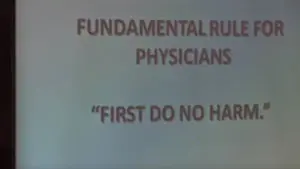

The Expert: Dr. Stephen Abram, an anesthesiologist based in Milwaukee, Wisconsin.

Dr. Stephen Abram, a Milwaukee-based anesthesiologist, testifies for the plaintiff in a Georgia medical malpractice trial involving a woman who suffered ultimately fatal brain damage from oxygen deprivation during an epidural injection for pain management. In this clip, Abram defines the standard of care in such procedures with a visual display of composed statements, while elucidating how he believes these standards were breached by the doctor responsible for the patient’s safety.
Abram first emphasizes the overall point that safety is paramount in any procedure, without exception. Doctors are taught first and foremost in medical school, “Above all, do no harm.” In this regard, it is critical to “take no chances with a patient’s ability to breathe.” He adds that the standard of care demands that chances should not be taken with heart or brain function, either.
The expert then details how breathing is customarily monitored in any patient undergoing a procedure like this one. The health care provider must ensure that the patient’s ventilation is adequate. This is accomplished by listening to breath sounds with a stethoscope, watching chest movements, using monitors that inform the doctor that oxygen is reaching the patient’s bloodstream, and observing the patient’s cardiovascular vital signs: the blood pressure and heart rate, which are signals that oxygen within the bloodstream is actually reaching the vital organs. Abram emphasizes that whenever a patient is sedated, pulse oximetry is the essential monitoring tool to determine whether there is enough oxygen getting into the bloodstream to support those vital organs.
Abram then outlines for jurors the “ABC’s of resuscitation,” the most basic teaching in healthcare. Abram explains that the airway must be open from mouth to lungs, that the patient must be either breathing on their own, or have the mechanics of ventilation provided for them, and that their circulation is adequate to get the oxygen to the heart, brain, and other vital organs.
Monitoring of vital signs is critical in determining whether a sedated or unconscious patient is breathing adequately, he says. And this is especially important when drugs such as propofol, Versed, and opiates like fentanyl are being used because these drugs will suppress the brain’s signals to the respiratory system. Whenever such sedation is used, it would be a breach in the standard of care not to monitor the vital signs. Without proper monitoring, suppression of the respiratory or cardiovascular system by the sedating medications would go unrecognized and could result in severe damage, as in this case. Indeed, if these monitors indicate a deficiency, the procedure should be stopped.
Abram tells jurors the patient’s state of consciousness must also be monitored by whomever is administering the sedative. This is accomplished by communicating with the patient. If the patient fails to respond, the procedure must be interrupted and an evaluation of the situation take place to be sure that it is safe to continue. This is especially relevant when a nurse is the monitor. The physician doing the procedure cannot also do the monitoring or evaluation as long as he continues to perform the procedure. However, in this case Abram points out that there is no evidence that monitoring took place. There was no stethoscope to listen to the breathing, there was no written record of the respiratory rate, and no evidence of any evaluation of the patient’s level of consciousness. A procedure like this could easily be stopped to accomplish such an evaluation. With an epidural for pain there is no risk in simply removing the needle and then evaluating the situation.
Abram’s testimony was particularly damning when attesting to the accuracy of the treating physician’s documentation in this case. These notes, “seem to have very little bearing on the events that took place… more of a ‘flight of ideas’,” and do not give any real indication of what happened during this procedure, Abram says.
The expert here very elegantly supports allegations of sloppy medical care, poor judgment, disregard for the basics of patient safety, and inadequate documentation that together led to a $21.98 million medical malpractice verdict for the plaintiff.
Gary Gansar, MD, is residency-trained in general surgery. He served as Chief of Surgery and Staff at Elmwood Medical Center and on the Medical Executive Committee at Touro Infirmary and Mercy Hospital in New Orleans, LA. Dr. Gansar was Board Certified in general surgery while in active practice. He joined AMFS in 2015 as a Physician Medical Director.
The medical expert witness partner for attorneys serious about building a winning case
AMFS is your trusted source for highly-qualified medical expert witnesses. After pioneering the field nearly three decades ago, we’re continuing to redefine medical expert witness services by providing value far beyond a referral alone.
Our Physician Medical Directors know what it takes to build a strong case. Our medical expert witnesses leave no doubt. And our case managers streamline billing and logistics every step of the way, letting you focus on what you do best: constructing your winning case. Explore why AMFS clients expect more from their medical expert witnesses—and get it.
